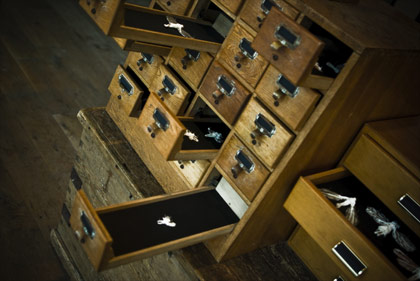
| HOME |
| NERVE |
| REVIEWS |
| ARCHIVE |
| EVENTS |
| LINKS |
| ABOUT US |
| CONTRIBUTORS |
| BACK ISSUES |
| CONTACT US |
 Life
is Like This...
Life
is Like This...
The Gallery, Clayton
Square
16th - 19th September 2010
Reviewed by Sebastian Gahan
The Gallery, in Clayton Square, where I visited for the first time today, is truly as as it's name card suggests. That is, "Liverpool's Best Kept Secret." Open for only a short time, as part of the Biennial Independents, Life is Like This is a surprising and thoughtful show of work by various disabled artists.
The compact, welcoming space houses a small selection of pieces from many digital based or non-traditional formats that show a good range of feelings and expression via some unique pieces of work. I had the pleasure of meeting a few of the artists involved, and amongst them was Pauline Hayes, whose striking piece "Restricted Movement" caught my eye almost immediately upon my entry to the space. In an embodiment of the less is more movement, her piece is a wheelchair with a car clamp chained to it and a lovely DVLA sticker announcing to the chairs owner that they have a fine to pay. As Pauline says, the piece has a message that is clear and is a message that is very important in an exhibition such as this.
Another piece that caught my eye was Jess Prince's The Secret Collection, an at first glance not particularly striking piece that reveals itself when one opens one of the many drawers of the ex-library cabinet holding the pieces in it's grasp. Inside the drawers are a multitude of unique, hand crafted fairies with pained expressions on their faces, in the throes of death or dead. Co-Founder of Digial Production for Disabled People, Max Zadow, called the piece "one of the best of the Biennial" during my chat to him, and the story behind the piece, of loss, grief and finding a portal out of those emotions via the creation of the piece is a human one that is easily identified with by anyone who has lost a loved one.
In fact, Zadow's own work, the intriguingly titled "Civvy Rations for when not on the run from Zombies and/or civil unrest/natural disasters" is also a very human piece in it's intentions. To create the piece Zadow filled a box with items that could feasibly help a person survive for the rest of their life, including food supplies, whiskey, a torch and much more. In speaking with Zadow I found out that the piece was a physical representation of the artist seeking to put his hands on the tools that he couldn't use, such as army supplies like energy biscuits, when the Scouts wouldn't accept him because of his disability. This piece to me seems to represent a very human desire to find a distinctly personal space to escape to where life can be perfectly catered for. It was indeed a statement to behold in these days of uncertainty.
There are many more pieces on show as well, and all of them are testament to the inherent creativity present in every individual regardless of their obvious or not so obvious disability. This is particularly evident in the photography of members of St Helens based Art from the Bag, where persons with mental illness were given a digital camera and allowed to be creative as an aid to becoming more social again. The shot of the inside of a foil bag of crisps is a good example of this, as is the snippet of the artist lead project where people were asked to help the environment and their creativity by saving the bottles that are normally throw away to be used for the piping of the, when fully installed, water way of drinks bottles.
In summation, very rarely can a small exhibition make you think so much about what art can actually do for the person rather than just the art itself, as one is traditionally encouraged to do.
Sorry Comments Closed
Comment left by Gill on 3rd October, 2010 at 18:20
The work produced in conjuction with St Helens Coalition of Disabled People ,did ,in fact, consist of people who have the label 'learning disability', rather than mental illness.The outcomes we achieved were amazing, not just because of the fantastic work that was produced, but breaking down barriers ,by engaging in mainstream activity.Thanks so much to Art From aBag , in particular Tony Maher for his input.